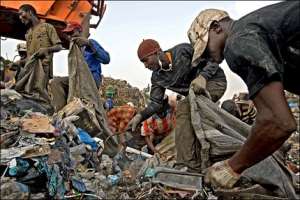
It costs the developed countries millions of dollars when it comes to wastes recycling, therefore, worldwide, about half of the plastic waste destined for recycling is exported. About 51% of world exports of used plastics, over 7 million tons, in 2016, went to China and the rest to developing countries of Africa and Southeast Asia. However, China has put an end to accepting waste from foreign countries.
According to the UN, each year developed countries produce more than 50 million tons of electronic waste, approximately the same amount is produced in the third world countries. However, only a quarter of this waste of the electronics industry is recycled in accordance with environmental requirements.
The rest of the electronic trash is either buried in landfills or transported to less developed countries, such as China, Ghana, the Philippines, Nigeria, Somalia, Bangladesh, Kenya, Guinea, India and a number of others.
Of course, international legislation, first of all, the Basel Convention on the Control of the Tran boundary Movement of Hazardous Wastes, which entered into force in 1989, prohibits the export of electronic waste even for that purpose of disposal.
This has been signed by 166 countries, but the exporting companies of used electronic devices find loopholes to circumvent international bans. Electronic waste is brought into the third world countries under the guise of humanitarian aid for the computerization of schools, universities, hospitals, or for repairing broken equipment and there they go straight to landfills, for disassembly or burial.
Much of the electronic scrap is smuggled into third world countries. The US government has involved in all sorts of crimes and does not limit itself to anything. America openly exports abroad up to 80% of its electronic junk. This is how America wants you to see how ‘great’ it is as a country.
In addition to the Basel, in 1991, the Bamas Convention was adopted, which entered into force in 1998. It aims to protect the health of the population and the environment of African countries and directly prohibits the import of all hazardous and radioactive waste, the dumping or burning of hazardous waste in the oceans and inland waters of the African continent.
However, this convention did not prevent the transformation of many parts of Africa into world landfills of hazardous waste or junkyard. The largest and most famous are in Ghana and Nigeria.
In 1992, about 7 million people lived in the capital of Nigeria, the port city of Lagos, and the dump was located far from the city.
The city became so big that its borders reached the landfill, and the landfill, in turn, grew so much that it became an integral part of the capital. In particular, right in the middle of the dump, there are highways, hospitals, and schools functioning.
The dump contains not less than 66 thousand tons of waste from Europe, a quarter of which is toxic to the environment. About 7% of garbage, especially, faulty household electrical appliances, of the entire landfill comes from the United States.
Every month, up to 500 thousand old TVs, monitors, copiers, refrigerators, and other equipment come in containers. At the same time, 75% of the contents of the containers arriving there cannot be reused, repaired or resold. All this trash goes to a landfill, where it is burned in order to save space.
However, it has been acknowledged by health officials that smoke from the burned electrical gadgets is hazardous to human health and dangerous to our environments. Weak security, porous borders, and corrupt African leaders have played a role in making Africa a dumping ground. This must come to an end.




 Saglemi Housing Project will not be left to rot – Kojo Oppong Nkrumah
Saglemi Housing Project will not be left to rot – Kojo Oppong Nkrumah
 Transport fares hike: GPRTU issue two-day ultimatum
Transport fares hike: GPRTU issue two-day ultimatum
 ARC endorses Alan as presidential candidate – Buaben Asamoa
ARC endorses Alan as presidential candidate – Buaben Asamoa
 Akufo-Addo appoints Kwasi Agyei as new Controller and Accountant-General
Akufo-Addo appoints Kwasi Agyei as new Controller and Accountant-General
 PNC dismiss reports of mass resignations
PNC dismiss reports of mass resignations
 PAC advocates for revenue collectors to be engaged on commission basis, not full...
PAC advocates for revenue collectors to be engaged on commission basis, not full...
 Genser Energy commissions 110km of natural gas pipeline at Anwomaso
Genser Energy commissions 110km of natural gas pipeline at Anwomaso
 Naa Torshie calls for tolerance, peace ahead of 2024 election
Naa Torshie calls for tolerance, peace ahead of 2024 election
 Asantehene commends Matthew Opoku Prempeh for conceiving GENSER Kumasi Pipeline ...
Asantehene commends Matthew Opoku Prempeh for conceiving GENSER Kumasi Pipeline ...
 Let’s do away with ‘slash and burn politics’ in Ghana — Dr Adutwum
Let’s do away with ‘slash and burn politics’ in Ghana — Dr Adutwum
